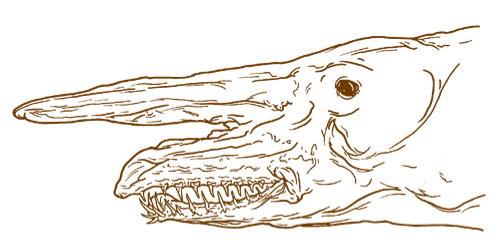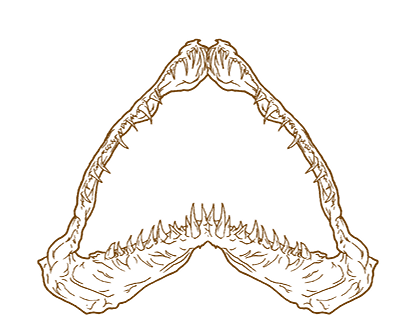
Goblin Shark
Mitsukurina owstoni
(mit-soo-kur-e-na o-stone-e)

The goblin shark is a secretive beast. These sharks spend most of their time deep in the ocean and are very rarely seen by other animals—even by other goblin sharks. They’re definitely not the loveliest specimens, but there’s a good reason for their gruesome appearance.
Unlike other sharks, the goblin shark has retractable, flexible jaws, which means they can very quickly thrust their mouth outward, crammed full of menacing teeth, to snap up passing meals. This helps them catch prey without having to propel their whole body forward. Such a large deep-sea animal needs to conserve energy as much as possible, so this adaptation is very useful.
Goblin sharks grow to around 13 feet (4 m) long. Except for their pinkish-purple coloring, they resemble most other species of shark when their jaws aren’t extended.
Where They Live
Scientists believe goblin sharks live mainly in the waters around Japan, because that’s where the most recorded sightings have taken place. However, they’ve also been spotted throughout the Atlantic, Pacific, and Indian Oceans, and even off the coasts of New South Wales and Tasmania in Australia. To find them yourself, you must be at depths of 130 to 4,265 feet (40–1,300 m), hanging out near the seabed.

What They Eat
With their powerful mouths, they feast on squid, fish, crabs, and crustaceans. Because there’s so little light deep in the ocean, goblin sharks, like other deep-sea creatures, don’t really need good eyesight. Instead, they rely on their snout—not to sniff out their prey, but to find it with electricity! Their snout is full of electroreceptors: special sensory cells that allow them to pick up electrical signals. This allows them to burrow through the seabed and sense where potential prey may be hiding.
Conservation Status
Least Concern
Little is known about these deep-water sharks. However, researchers believe there are very few threats to their survival other than being accidentally caught by deep-sea trawlers, which also harm their seafloor habitats.

Fun Facts
